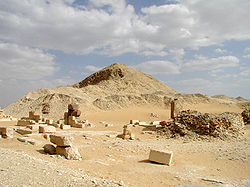
Iput II
Encyclopedia
- About the river in Belarus and Russia see Iput RiverIput RiverThe Iput River is a river in Mahilyow and Homyel Voblasts in Belarus and Smolensk and Bryansk Oblasts in Russia. It is a left tributary of the Sozh River. The length of the Iput River is 437 km. The area of its basin is 10,900 km². It freezes up in late November and stays icebound until...
. For the early 6th dynasty queen, wife of UnasUnasUnas was a Pharaoh of Ancient Egypt, and the last ruler of the Fifth dynasty from the Old Kingdom. His reign has been dated as falling between 2375 BC and 2345 BC...
see IputIputIput I was a Queen of Egypt, a daughter of King Unas, the last king of the Fifth dynasty of Egypt. She married Teti, the first Pharaoh of the Sixth dynasty of Egypt. Their son was Pepi I Meryre.-Life:...
.
Iput was an ancient Egypt
Ancient Egypt
Ancient Egypt was an ancient civilization of Northeastern Africa, concentrated along the lower reaches of the Nile River in what is now the modern country of Egypt. Egyptian civilization coalesced around 3150 BC with the political unification of Upper and Lower Egypt under the first pharaoh...
ian queen consort of the Sixth dynasty
Sixth dynasty of Egypt
The sixth dynasty of ancient Egypt is often combined with Dynasties III, IV and V under the group title the Old Kingdom.-Pharaohs:...
, a sister and wife of Pepi II.
Titles
Her titles King’s Daughter (z.t-nỉswt), and Eldest King’s Daughter (z.t-nỉswt-šms.t) show that Iput II was a daughter of a pharaoh (Pepi I). The title Hereditary Princess (ỉrỉỉ.t-pˁt) identifies her as a noble lady.As a queen consort she held the following titles: King’s Wife (ḥm.t-nỉswt ), King’s Wife, his beloved (ḥm.t-nỉswt mrỉỉ.t=f), Beloved King’s Wife of Neferkare-men-ankh (ḥm.t-nỉswt mrỉỉ.t=f nfr-k3-rˁ-mn-ˁnḫ), Beloved King’s Wife of Neferkare-men-ankh-Neferkare (ḥm.t-nỉswt mrỉỉ.t=f nfr-k3-rˁ-mn-ˁnḫ-nfr-k3-rˁ), and She who sees Horus and Seth (m33.t-ḥrw-stš).
Burial

Saqqara
Saqqara is a vast, ancient burial ground in Egypt, serving as the necropolis for the Ancient Egyptian capital, Memphis. Saqqara features numerous pyramids, including the world famous Step pyramid of Djoser, sometimes referred to as the Step Tomb due to its rectangular base, as well as a number of...
and her tomb contains a version of the Pyramid Texts
Pyramid Texts
The Pyramid Texts are a collection of ancient Egyptian religious texts from the time of the Old Kingdom. The pyramid texts are possibly the oldest known religious texts in the world. Written in Old Egyptian, the pyramid texts were carved on the walls and sarcophagi of the pyramids at Saqqara during...
.
In one of the storerooms of the mortuary temple excavators discovered the granite sarcophagus of Queen Ankhesenpepi IV
Ankhesenpepi IV
Ankhesenpepi IV was an ancient Egyptian queen, a wife of Pharaoh Pepi II of the Sixth dynasty. She was the mother of King Neferkare II. Pepi II also had several other wives.- Titles :...
, another wife of Pepi II. It is not entirely clear if Ankhesenpepi IV was originally buried in the burial complex of Iput II, or if she was originally interred elsewhere and reburied during the First Intermediate Period.
Ankhesenpepi's sarcophagus is inscribed with an interesting historical text which sheds some light on the history of the early part of the 6th dynasty. The text inscribed on the sarcophagus has been very hard to decipher but at least partial translations have been possible. From the text it is now clear that Userkare
Userkare
Userkare was the second king of the Sixth Dynasty. He is generally seen as one of the leaders who opposed his predecessor, Teti's royal line and was most likely an usurper to the throne...
reigned some four years, but the practice of damnatio memoriae
Damnatio memoriae
Damnatio memoriae is the Latin phrase literally meaning "condemnation of memory" in the sense of a judgment that a person must not be remembered. It was a form of dishonor that could be passed by the Roman Senate upon traitors or others who brought discredit to the Roman State...
later lead to his name being expunged from the records.

